Tags
basilica, dragon, Italy, relic, reliquary, Saint George, Saint Mark, Saint Theodore, Venice
 Saint Theodore Arrives in Venice
Saint Theodore Arrives in Venice
He arrived in Venice from the East in pieces: a torso and cuirass, a disembodied head, a crocodile. The Sack of Constantinople in 1204 had devastated the city, but the Venetians, who had transported the army of the Fourth Crusade to Constantinople, managed to salvage an enormous horde of objects from the captured city. The Venetians systematically shipped these objects – statues, jeweled reliquaries, architectural columns, and marble pediments – back to Venice. Among the crates were several fragments of statuary that, when recombined, would become a statue of Saint Theodore, the great warrior-saint, dragon-slayer, and a patron saint of Venice.
Saint Theodore of Amasea
Saint Theodore of Amasea was a Roman recruit martyred in the early 4th century for professing his faith in Christianity. As a new recruit, he is also known as Saint Theodore Tiro, tiro meaning “recruit” in Latin.[1] Saint Theodore of Amasea is often confused with another Theodore – Saint Theodore of Stratelates, a Roman general – although most scholars believe the two Theodores were probably the same person.[2] Butler’s Lives of the Saints notes that the stories relating to Saint Theodore of Amasea “cannot be relied on,” although they probably refer to “a real martyr who may or may not have been a soldier.”[3] Butler’s Lives of the Saints continues, “So complicated and contradictory did his story become that, in order to make it less inconsistent, a second soldier St Theodore had to be posited and so we have the St Theodore Stratelates of February 7.”[4] Saint Theodore of Amasea’s feast day is November 9.
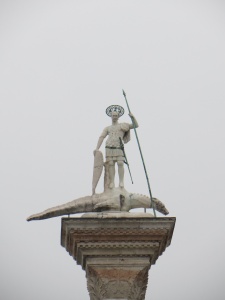 The first known mention of Saint Theodore of Amasea derives from a panegyric delivered by Saint Gregory of Nyssa near Saint Theodore’s tomb in Euchaita, modern-day Turkey.[5] According to various legends, when Saint Theodore refused to offer sacrifices to the Roman gods along with his legion he was brought before the governor of the province to explain himself. He declared himself to be a Christian, and when asked why he would profess faith in an outlawed religion, the worship of which was a capital offense, he responded, “I know not your gods. Jesus Christ, the only Son of God, is my God.”[6] He was dismissed and, according to some sources, went into the city of Amasea near the Iris River and burned down the temple of Cybele.[7] Not surprisingly, he was captured and was again brought before the Roman authorities who questioned and cajoled him, and then tortured him.[8] When he was returned to his prison cell, he was comforted by visions of angels.[9] Eventually, he was condemned to death and was burned alive in a furnace.[10]
The first known mention of Saint Theodore of Amasea derives from a panegyric delivered by Saint Gregory of Nyssa near Saint Theodore’s tomb in Euchaita, modern-day Turkey.[5] According to various legends, when Saint Theodore refused to offer sacrifices to the Roman gods along with his legion he was brought before the governor of the province to explain himself. He declared himself to be a Christian, and when asked why he would profess faith in an outlawed religion, the worship of which was a capital offense, he responded, “I know not your gods. Jesus Christ, the only Son of God, is my God.”[6] He was dismissed and, according to some sources, went into the city of Amasea near the Iris River and burned down the temple of Cybele.[7] Not surprisingly, he was captured and was again brought before the Roman authorities who questioned and cajoled him, and then tortured him.[8] When he was returned to his prison cell, he was comforted by visions of angels.[9] Eventually, he was condemned to death and was burned alive in a furnace.[10]
Here Be Dragons
Notably absent from these stories is any mention of dragons or dragon slaying. Why, then, is Saint Theodore frequently depicted slaying a dragon? Saint Theodore’s identification as an heroic dragon-slayer may be related to the belief that by his intercession “devils were expelled and distempers cured.”[11] In The Dragon in Medieval East Christian and Islamic Art, Sara Kuehn suggests that the belief in Saint Theodore’s power to vanquish evil probably inspired the dragon-slaying motif.[12] Kuehn writes, “Dragon-slaying riders were progressively identified as warrior saints and can conclusively be interpreted as exercising an apotropaic or protective function.”[13]
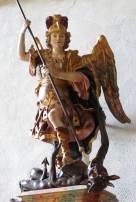
In early Christian art, Saint Theodore is often depicted with fellow dragon-slayer Saint George, although portrayals of Saint Theodore slaying a dragon predate those of his more famous companion. Kuehn states, “Among the military saints Theodore and George were predominantly associated with the miracle of dragon-slaying and often appear together. In the hagiographical tradition, Saint Theodore clearly preceded Saint George in the role of dragon-slayer.”[14] Early references to Saint Theodore slaying a dragon can be traced to the late 9th century[15] while the earliest known depiction of Saint George smiting a dragon is from the early 11th century.[16] Before then, Saint George was sometimes shown killing a man rather than a dragon.[17] Other saints frequently depicted with dragons include Saint Margaret, Saint Martha, Saint Sylvester, the Apostle Philip, and the Archangel Michael (pictured in the carved sculpture, above, located at the Minster of the Holy Cross, Rottweil, Germany).[18]
Saint George and the Dragon
Incidentally, the celebrated story of how Saint George vanquished a dragon and rescued a princess was likely a later embellishment to the legend of Saint George the martyr – and one that clearly captured the imagination of subsequent generations. Most famously told in the Legenda Aurea (Golden Legend), Saint George was a Christian knight born in Cappadocia who, while out riding in the province of Lybia, arrived at the city of Sylene. The city’s inhabitants were being terrorized by a terrible dragon, which they attempted to appease by providing two sheep every day. When the inhabitants ran out of sheep, they substituted a human victim, who was selected by lot. On the day of Saint George’s arrival, the king’s daughter had been selected to serve as the sacrifice. Saint George ultimately rescued the princess, but before he would slay the dragon, the saint elicited the people’s promise to convert to Christianity. This they promised, and once the dragon was killed, four oxcarts were needed to dispose of its carcass.[19]
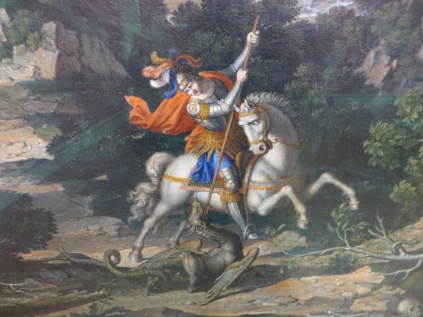
Joseph Anton Koch, Heroic Landscape with St. George (detail) (1807). Alte Pinakothek, Munich, German.
Butler’s Lives of the Saints observes that “the story of the dragon, though given so much prominence, was a later accretion of which we have no sure traces before the twelfth century.”[20] The authors further comment, “There is every reason to believe that St George was a real martyr who suffered at Diospolis (i.e. Lydda) in Palestine, probably before the time of Constantine. Beyond this there seems to be nothing which can be affirmed with any confidence.”[21] Although Saint George is not mentioned in the Syriac Breviarium, he is mentioned in the Heironymianum, and various pilgrims of the 6th to 8th century identified Lydda or Diospolis as the site of his relics.[22]
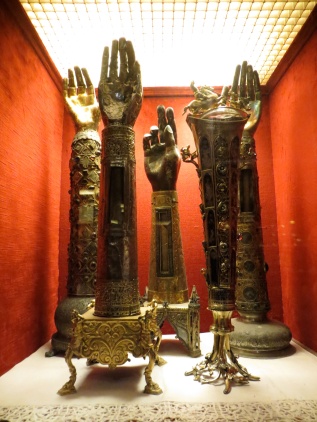
Arm Reliquaries, Basilica of Saint Mark
Coincidentally, the arm of Saint George was apparently one of four important relics taken from Constantinople to Venice following the sack of the city in 1204.[23] Located today in the Treasury of Saint Mark’s Basilica, the Reliquary of the Arm of Saint George (pictured above, in the right foreground) features an unusual cone-shaped exterior, oval in cross-section, of silver gilt and enamel and a glass lid topped with a figure of Saint George on horseback spearing a dragon.[24]
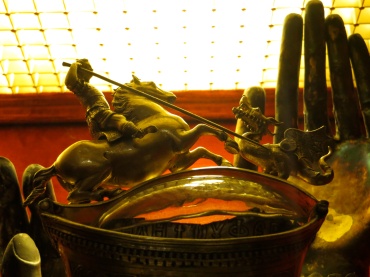
Reliquary of the Arm of St. George (detail of lid)
A plaque on the lowest part of the reliquary case, above the stems and leaves that form the base, reads in reserve against niello, “ISTVT · EST · BRAC/HIVM · GLORIOXIS/IMI · MARTIRIS S/ANCTI · GEORGEII” (“This is the arm of the most glorious martyr, Saint George”).[25] This exterior, of Venetian design, dates to before 1325.[26] The outer reliquary holds an earlier Byzantine reliquary made of silver that dates to before 1204.[27] While the dragon is likely original, the equestrian figure of Saint George is probably more modern, dating to the 16th century.[28] According to some sources, Saint George became Venice’s third patron saint – after Saints Mark and Theodore – sometime following the translation of his arm to the city.[29]
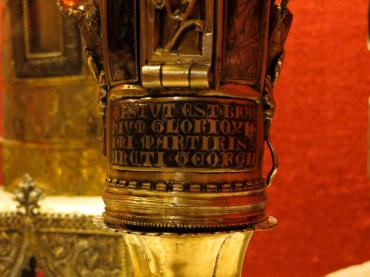
Reliquary of the Arm of St. George (plaque in reserve against niello)
He Came in Pieces
As noted above, the statue of Saint Theodore arrived in Venice in various pieces, although the pieces were not, in fact, part of a single, unified work. Edward Hollis, who writes about the evolution and transformation of buildings over time in The Secret Life of Buildings, explains how the Venetians recombined disparate sculptural fragments pilfered from Constantinople to create a single, monumental statute of their patron saint.[30]
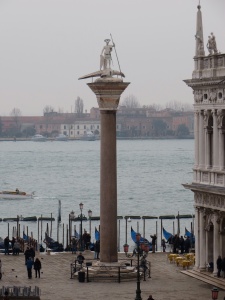 After the Venetians left Constantinople, some of the treasures they had appropriated were lost at sea and some were sold along the journey, but most of the objects arrived safely in Venice, where they were unloaded and unpacked at the Arsenale.[31] After they were evaluated by various officials, they were eventually repurposed to enhance the beauty, status, and prestige of La Serenissima. For example, building material and other decorative ornaments stripped from the churches of Constantinople were used to clothe the basilica of Saint Mark “in the borrowed raiment of vanished sanctuaries” so that “what had been an austere brick structure soon shone, and sparkled, and flashed in the sun.”[32]
After the Venetians left Constantinople, some of the treasures they had appropriated were lost at sea and some were sold along the journey, but most of the objects arrived safely in Venice, where they were unloaded and unpacked at the Arsenale.[31] After they were evaluated by various officials, they were eventually repurposed to enhance the beauty, status, and prestige of La Serenissima. For example, building material and other decorative ornaments stripped from the churches of Constantinople were used to clothe the basilica of Saint Mark “in the borrowed raiment of vanished sanctuaries” so that “what had been an austere brick structure soon shone, and sparkled, and flashed in the sun.”[32]
Hollis explains that a centurion’s cuirass, a crocodile, and a disembodied head “became the body of Saint Theodore.”[33] Similarly, a pair of brazen angel’s wings and a lion were “welded together to make the emblem of Saint Mark.”[34] Both of these new creations were hoisted atop a pair of Numidian granite columns, also taken from Constantinople, and set in Saint Mark’s Square.[35] The two statutes, symbolizing two patron saints of Venice, remain in the square to this day.[36]
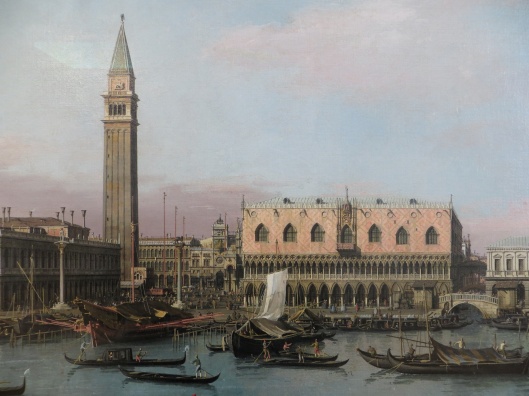
Antonio Canaletto, Piazzetta in Venice. Alte Pinakothek, Munich, Germany.
[1] 4 Butler’s Lives of the Saints 302, 301-303 (Herbert J. Thurston, S.J. & Donald Attwater eds., 2d ed. 1956). Alternatively, Butler’s Lives of the Saints suggests that the surname Tiro more probably derives from his membership in the Cohors tironum. Id.
[2] See, e.g., id.; Rosa Giorgi, Saints in Art 345 (Stefano Zuffi ed. & Thomas Michael Hartmann trans., 2002) (“Beginning in the tenth century, Theodore split into two figures in popular devotion, a general and a soldier that were really the same person.”).
[3] Butler’s Lives of the Saints, supra note 1, at 302.
[4] Id.
[5] See, e.g., id. at 301.
[6] Id. at 302.
[7] See, e.g., Giorgi, supra note 1, at 345; Butler’s Lives of the Saints, supra note 1, at 302.
[8] Butler’s Lives of the Saints, supra note 1, at 302.
[9] See, e.g., Giorgi, supra note 1, at 345; Butler’s Lives of the Saints, supra note 1, at 302.
[10] Butler’s Lives of the Saints, supra note 1, at 302
[11] Id. (citing the panegyric attributed to Saint Gregory of Nyssa).
[12] See Sara Kuehn, The Dragon in Medieval East Christian and Islamic Art 109 (2011).
[13] Id.
[14] Id. at 108.
[15] Id. at 108 n.215 (“His exploit of vanquishing a dragon with a spear only appeared in the second state of his Passio Prima (dated 890) . . . .”). Kuehn also notes that the 7th century Passion of Marina of Antioch contains “antecedents” of Saint Theodore’s dragon-slaying. Id.
[16] Id. at 108 n.216. Kuehn identifies the church of Saint Barbara at Soganli as possessing the earliest identifiable portrayal of Saint George vanquishing a dragon. Id.
[17] Id. at 108.
[18] See, e.g., George Ferguson, Signs and Symbols in Christian Art 16 (1954).
[19] See 2 Butler’s Lives of the Saints 148-50 (Herbert J. Thurston, S.J. & Donald Attwater eds., 2d ed. 1956).
[20] Id. at 149.
[21] Id.
[22] Id. at 150.
[23] See, e.g. Treasures of Heaven: Saints, Relics, and Devotion in Medieval Europe 92 (Martina Bagnoli et al., eds., 2010). The other three important relics were a relic of the Holy Blood, a piece of the True Cross, and the head of Saint John the Baptist. Id.
[24] Id. The lid was originally made of rock crystal. Id.
[25] William D. Wixsom, Western Metalwork, in The Treasury of San Marco Venice 282 (David Buxton ed., 1984).
[26] Treasures of Heaven, supra note 23, at 92.
[27] Id.
[28] Wixsom, supra note 25, at 282. Wixsom writes, “The horse and rider are probably directly based on Leonardo’s designs for the Sforza and Trivulzio monuments, dating respectively 1485-93 and 1506-13, even though the theme of a rearing horse goes back to the early Florentine Renaissance sculptor, Bertoldo (1420-91), to Paduan bronzes dating around 1510, and to ancient bronzes.” Id. (citations omitted).
[29] See, e.g., id.; Treasures of Heaven, supra note 23, at 92.
[30] See Edward Hollis, The Secret Lives of Buildings (2009).
[31] Id. at 55.
[32] Id.
[33] Id.
[34] Id.
[35] Id.
[36] The statute of Saint Theodore in Saint Mark’s Square, however, is a replica. The original is now located in the Doge’s Palace. A sign next to statue states that the marble statue “is a fourteenth-century sculpture with an ancient armoured bust and a young man’s head of different origins. . . . According to tradition, the saint’s face is a portrait of Mithradates of Pontus.”


 Saint Mark, the symbol is everywhere in the city. Chiseled onto buildings, stamped onto tiles, and stitched into flags, it serves as a constant reminder of the enduring relationship between city and saint. The glorification of Saint Mark in Venetian culture, however, came at the expense of another saint, Saint Theodore of Amasea. Once Venice’s sole patron, Saint Theodore’s influence declined after Saint Mark’s arrival, although he is still afforded a place of honor atop a pillar in Saint Mark’s Square.
Saint Mark, the symbol is everywhere in the city. Chiseled onto buildings, stamped onto tiles, and stitched into flags, it serves as a constant reminder of the enduring relationship between city and saint. The glorification of Saint Mark in Venetian culture, however, came at the expense of another saint, Saint Theodore of Amasea. Once Venice’s sole patron, Saint Theodore’s influence declined after Saint Mark’s arrival, although he is still afforded a place of honor atop a pillar in Saint Mark’s Square.
 Akroyd explains, “The body of Saint Mark was taken out of the sarcophagus and unwrapped from its silk shroud, the relic being substituted by another and less eminent saint. It was then placed in a chest and taken on board the Venetian ship, the merchants first ensuring that the saint’s remains were covered by a layer of pork and cabbage. When the Muslim officials asked to inspect the chest, they cried out ‘Kanzir, kanzir’ (Oh horror) at the sight and smell of the pork. . . . Thus the evangelist was safely conveyed to Venice, but not before a number of miracles eased his passage across the Mediterranean.”
Akroyd explains, “The body of Saint Mark was taken out of the sarcophagus and unwrapped from its silk shroud, the relic being substituted by another and less eminent saint. It was then placed in a chest and taken on board the Venetian ship, the merchants first ensuring that the saint’s remains were covered by a layer of pork and cabbage. When the Muslim officials asked to inspect the chest, they cried out ‘Kanzir, kanzir’ (Oh horror) at the sight and smell of the pork. . . . Thus the evangelist was safely conveyed to Venice, but not before a number of miracles eased his passage across the Mediterranean.” Saint Mark’s body was initially kept in a chapel at the Doge’s palace, a chapel originally dedicated to Saint Theodore, until a more suitable church could be built. Begun in 829, the year after the translation of Saint Mark’s relics, the first church of Saint Mark was completed in 832. This church was destroyed in 976 during a rebellion against Doge Pietro Candiano IV. A second church was built in 1063 but was not consecrated until 1094, after Saint Mark’s relics, which had been lost in the years following the destruction of the first church, were rediscovered.
Saint Mark’s body was initially kept in a chapel at the Doge’s palace, a chapel originally dedicated to Saint Theodore, until a more suitable church could be built. Begun in 829, the year after the translation of Saint Mark’s relics, the first church of Saint Mark was completed in 832. This church was destroyed in 976 during a rebellion against Doge Pietro Candiano IV. A second church was built in 1063 but was not consecrated until 1094, after Saint Mark’s relics, which had been lost in the years following the destruction of the first church, were rediscovered. During my visit to the basilica, Saint Mark’s simple, marble sarcophagus could only be viewed from behind the high altar. The exterior of the sarcophagus was well lit and a short inscription applied to the stone in metallic letters read: “SALUTAT VOS . . . MARCUS FILIUS MEUS.” This inscription was followed by a citation in much smaller letters below the word “MEUS.” The citation read “1 Petri 5.13,” the source of the abbreviated quote on the tomb. The front of the sarcophagus apparently proclaims “CORPUS DIVI MARCI EVANGELISTAE” (Body of the Divine Mark, Evangelist).
During my visit to the basilica, Saint Mark’s simple, marble sarcophagus could only be viewed from behind the high altar. The exterior of the sarcophagus was well lit and a short inscription applied to the stone in metallic letters read: “SALUTAT VOS . . . MARCUS FILIUS MEUS.” This inscription was followed by a citation in much smaller letters below the word “MEUS.” The citation read “1 Petri 5.13,” the source of the abbreviated quote on the tomb. The front of the sarcophagus apparently proclaims “CORPUS DIVI MARCI EVANGELISTAE” (Body of the Divine Mark, Evangelist).